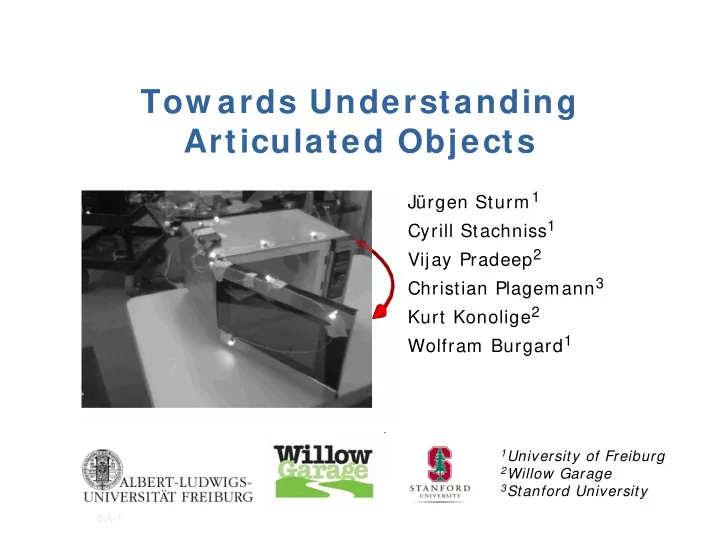

Tow ards Understanding Articulated Objects Jürgen Sturm 1 Cyrill Stachniss 1 Vijay Pradeep 2 Christian Plagemann 3 Kurt Konolige 2 Wolfram Burgard 1 1 University of Freiburg 2 Willow Garage 3 Stanford University SA-1
Motivation � Domestic environments � Articulated objects � Doors � Drawers � Learning models of objects � Understanding the spatial movements can improve � Perception � Manipulation planning � Navigation
Problem Form ulation Given : noisy 6D pose observations of n rigid object parts x 1 ∈ R 6 , . . . , x n ∈ R 6 The goal of our approach is to M ij 1. learn models describing the relationship between two object parts M 2. infer the kinematic topology of the scene (which object parts are connected in which way)
Training a Model � Noisy observations � Consider a sequence of T observed relative x i ª x j transforms of , denoted by D ij = ( z 1 ij , . . . , z T ij ) M ij � Find a model that describes the connection between two object parts ( i and j ) � Maximize the likelihood of the observations given the model ˆ M ij = argmax M ij p ( D ij | M ij )
Tem plate Models M rigid � Rigid model M prismatic � Prismatic model M rotational � Rotational model M LLE/GP � Non-parametric model (“LLE/ GP model”)
Observation Likelihood ( 1 ) � What is the likelihood of an observation given a model? p ( z ij | M ij ) = ? � Models for articulated objects typically have a latent action variable a (e.g., door opening angle) ¡ ¢ − || f M ij ( a ) ª z ij || 2 /l p ( z ij | a, M ij ) ∝ exp � For computing the observation likelihood, we integrate over a R p ( z ij | M ij ) = a p ( z ij | a, M ij ) p ( a | M ij ) da
Observation Likelihood ( 2 ) � Assumption: all latent actions have the same likelihood R p ( z ij | M ij ) ∝ a p ( z ij | a, M ij ) da � Integration might be time consuming � Efficiently estimate value of latent action variable! p ( z ij | M ij ) ≈ max a p ( z ij | a, M ij ) � In our settings, this works well in practice for all observed models
Draw er: Moves on Line Segm ent � Estimate � axis e of movement (using PCA) � Estimate latent action a t ij = e · trans ( z t ij ª z 1 ˆ ij ) � Transformation function: ( a ) = z 1 f M prismatic ij ⊕ ae ij
Param etric Model for a Door � Estimate: � axis of rotation n � center of rotation c � rigid transform r � Estimate latent action � Transformation function: ( a ) = [ c ; n ] T ⊕ rot Z ( a ) ⊕ r f M rotational ij
Garage door: A Tw o-link Joint � Garage door runs in a vertical and a horizontal slider � Neither rotational, nor prismatic motion � There are objects which cannot be explained well by “standard” models
LLE/ GP: Non-param etric Model � For a articulation model, we need � Estimate the latent action a � Predict the expected transform � Assume that the data lies on R 6 (or close to) a low dimensional manifold in � Find latent low dimensional coordinates on the manifold � dimensionality reduction using locally linear embedding (LLE) � Then learn a Gaussian process regression for the transformation function f ( a ) = z ij
The LLE/ GP Model Sum m ary � Given: 6D obs. z ij ∈ R 6 � Find low-dim. manifold LLE → a ij ∈ R d z ij � Non-linear regression ( a ij , z ij ) → GP � Result: a mapping from the manifold coordinate system into the observations space a 0 GP → z 0 f ( a ) = z ij
Higher Dim ensional Manifolds � LLE can find the embedding for any given dimensionality ( d> 1 ) � GPs naturally take multi- dimensional input data Approach directly applicable
Finding the Topology of the Scene � Consider all possible models at the same time � Then select the models that maximize the data likelihood while minimizing the overall complexity cost M type = ij | M type ) + C ( M type 1 k log p ( D test − ) kD test ij ij ij ij � The model selection and inference of the topology is done by computing a minimum spanning tree
Experim ents � Microwave door [ PhaseSpace] � Cabinet with two drawers [ PhaseSpace] � Garage door [ Simulated] � Table [ ARToolkit]
Microw ave Door: Observations
Microw ave Door: Learned Model
Microw ave Door: Error Analysis
Cabinet w ith Tw o Draw ers
Cabinet: Learned Models
Garage Door: Error Analysis
Table
Table
Table
Conclusions � Novel approach for learning kinematic models for articulated objects � Uses a candidate set of parametric and non- parametric models � Parametric (rigid, prismatic, rotation) � Non-parametric models (LLE/ GP) � Infers the connectivity of the object parts by means of a minimum spanning tree Towards understanding space in domestic environments
Future W ork � Closed kinematic chains � Pose registration with natural features � Plan trajectories for door/ drawer opening
Thanks for Your Attention
Recommend
More recommend